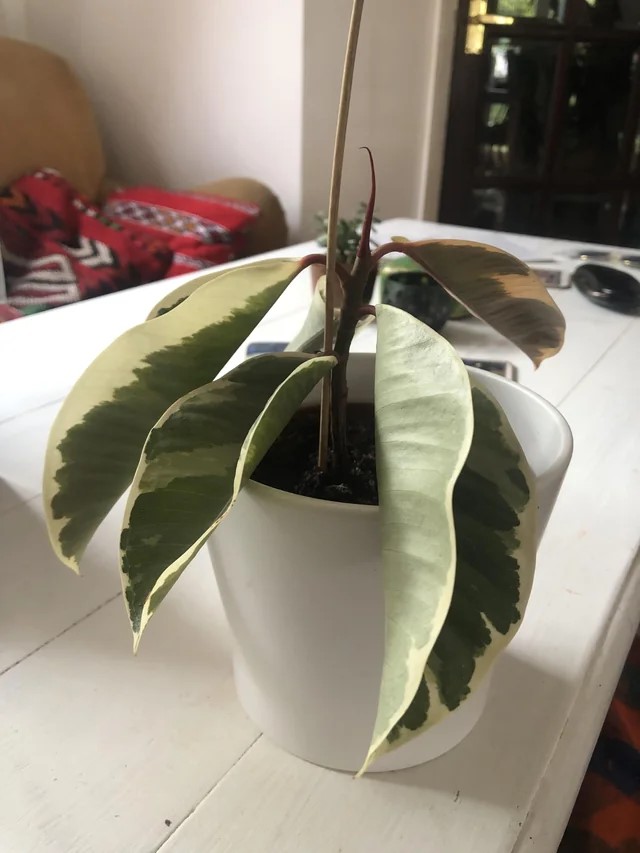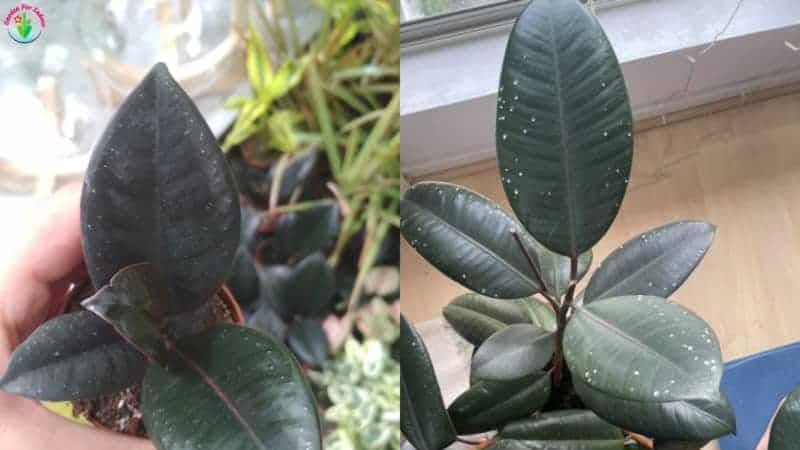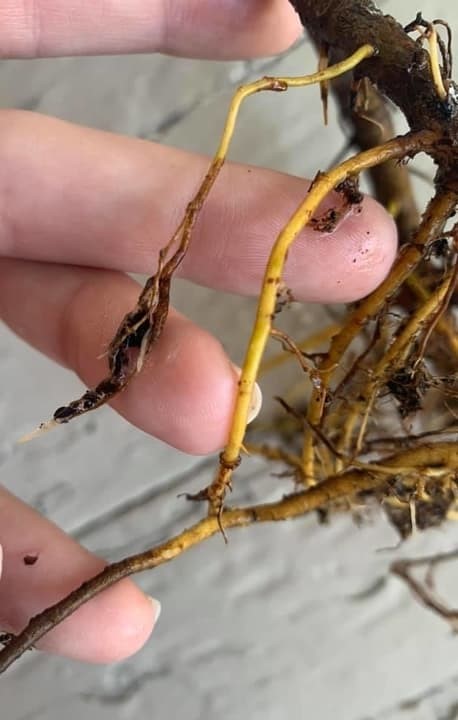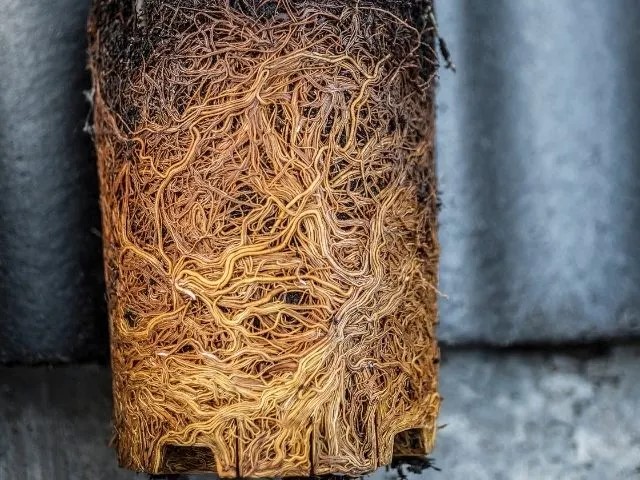The sleek look and air-purifying prowess of rubber plants led it to become a popular houseplant in recent years. It is fairly easy to grow as long as you know what makes it thrive and what can tick it off.
Rubber plant drooping leaves is one of its common problems that can be easily treated when diagnosed properly.
Several factors can cause houseplants, like rubber plants, to droop but the most common cause involves temperature and watering issues.
Rubber plants are the hardiest member of the ficus family. They can easily grow but they can be fickle with temperature and light.
Learn how changes in growing conditions affect your sleek and elegant-looking rubber tree and discover some tips on plant care based on its growing behavior.
Why Your Rubber Plant Leaves Are Drooping
Droopy leaves, curly edges, and discoloration are common signs of stress in house plants.
The thing is, it can be hard to figure out what causes plant stress since it contributes to a lot of factors. However, rubber plants usually droop their leaves because of these two reasons:
#1 Sudden changes in light and temperatures
Rubber plants do not like abrupt changes in their growing environment. With that behavior, many gardeners call them sensitive or fickle since they hate being moved to places that don’t provide their usual growing environment. They will easily droop when it is affected by the following conditions:

(1) Cold drafts and temperature fluctuations: Other than rubber plants, most houseplants, such as philodendrons and monstera, hate the cold. They get easily stressed with prolonged exposure to lower temperatures and can die in just days without warmth.
Rubber plants require growing temperatures around 60℉-77℉ to maintain the vigor and plumpness of their leaves. The leaves will start to show signs of stress when the temperature drops to 48℉-50℉.
Keep your rubber plants safe from temperature stress by keeping them away from open window sills and door gaps during winter and fall and away from air conditioning units.
(2) Low indoor humidity: If the relative humidity in the soil is low, the broad leaf surface of rubber plants serve as their secondary source of moisture. Aside from their roots, they absorb moisture from the humid air which contributes to their shiny and firm leaves.
When the indoor or outdoor relative humidity drops below 40%, rubber plants are more likely to display some signs of stress from their leaves like drooping and curling. You may use a hygrometer to monitor the indoor humidity and adjust it accordingly.
(3) The sudden increase in light conditions or decrease in light exposure: The unique behavior of rubber plants among other houseplants is its sensitivity to light exposure.
Its firm and shiny leaves require a consistent amount of bright indirect light during maturity.
Ideal locations for rubber plants are close to windows and doors that don’t receive direct sunlight.
Other than that, here are some of the crucial things you need to between the relationship between rubber plants and light exposure:
- Young rubber plants cannot tolerate excessive indirect light. Keep them at low indirect light until they mature enough to handle bright indirect light. The ideal type of light young rubber plant is the gentle early morning sun.
- Variegated rubber plants or those that have leaves with shades of cream, red, yellow, and green need more light than traditional rubber plants (dark green color).
- Mature rubber plants that receive low light conditions will also show some signs of stress, such as: Leggy growth or bigger distance between leaves, dropping lower leaves, stunted growth, small new leaves, and Few leaves.
- Direct sunlight can kill rubber plants. The first signs of stress include yellow and brown spots on the leaf edges.
#2 Watering issues
Watering issues are common problems for gardeners for houseplants. They often root from several factors affecting the water drainage and the root’s moisture absorption.
Rubber plant drooping leaves can both occur when the plant is overwatered and underwatered:

Overwatering and root rot
Rubber plants are drought-tolerant. They prefer being left without water for a few days than being watered all the time. For best results, it’s best to let the soil dry up to 50% before watering.
Signs that a rubber plant is overwatered, are as follows:
- Droopy leaves.
- Yellowing and browning leaves.
- Edema on the leaves.
Leaf edema is a sure sign of overwatering issues in rubber plants. It is the formation of white spots on the leaves that look like blisters. If you think that you overwatered your rubber plant, avoid watering it until it develops new growth.
Root rot
Overwatering often leads to root rot which makes the roots mushy and irreversibly damaged. As soon as you suspect that your plant has root rot, you must do the following steps:

- Uproot the rubber plant and remove the excess soil. Inspect the roots and check if there are still enough viable roots to save the plant.
- Cut the rotten roots using sanitized pruning shears and scissors.
- Re-pot the rubber plant into a new potting mix.
It’s easy to think that overwatering is caused by improper water application. However, other factors contribute to overwatering issues:
(1) Limited air circulation which slows down water evaporation: Good ventilation is crucial for houseplants since the soil dries up slower in indoor settings.
Without proper assessment of the current moisture in the soil, clueless gardeners will continue to water the plant, leading to overwatering.
(2) Size of pot: In general, the pot should correspond to the size of the plant. If the pot is too big for the plant, the soil moisture will take longer to dry.
On the other hand, having a small pot for a big rubber plant can cause the plant to be pot-bound or drought-stressed.
Here’s another thing, choosing a pot for rubber plants can be a bit tricky. Most rubber plant owners follow one rule of thumb in potting them: the size of the pot dictates the growth of the rubber tree.
Ideally, it’s best to train young rubber plants in small pots due to the following reasons:
- The potting mix in small pots dries up faster.
- The growing rubber plant will focus more on developing new leaves than extending its roots.
(3) Drainage holes: Some decorative pots used indoors have no drainage holes which can lead to a lack of soil drainage. Ensure that there are enough drainage holes on the pot to ensure proper water drainage.
(4) Soil composition: Rubber plants can be sensitive to light and temperature but they are not picky with their soil.
In their natural habitat, they prefer in-ground soil composition more than the usual potting soil. Here are two ideal potting combinations for your rubber plants:
Soil mix 1
- Loam soil 60% (for moisture retention)
- Perlite 20% (for drainage)
- Coco coir 10% (for water retention and aeration)
- Worm castings 10% (fertilizer)
Soil mix 2
- 1 part peat moss.
- 1 part pine bark.
- 1 part coarse sand or perlite.
Underwatering
Rubber plant drooping leaves can also be caused by under-watering issues.
The good news is that the impact of underwatering on rubber plants is more reversible and can be treated easily. It is usually caused by infrequent watering, a drop in humidity levels, or when the weather becomes warmer, especially during summer.
Signs that you underwatered your rubber plant are as follows:
- Drying or droopy leaves.
- Stunted growth.
- Shallow root system.
You can easily treat thirsty rubber plants through deep watering. You may also adjust the indoor humidity levels by:
- Misting using an atomizer or mister.
- Installing a humidifier.
- Place other house plants next to the rubber plant.
- Add a pebble tray to the room.
Other possible cause of rubber plant drooping leaves
Aside from the plant conditions mentioned above, here are some possible underlying plant conditions that may lead to rubber plant drooping leaves
(1) Nutrient deficiency: Lack of nutrients can be directly related to lack of fertilizer but may also be a secondhand condition when the plant develops root rot due to overwatering.
Try to simply add animal manure or a typical 14-14-14 fertilizer to the weak plant and observe how it recuperates well.
(2) Root bound: The roots can overgrow inside a pot and choke itself. If left untreated, it may lead to underwatering issues, droopy leaves, and leaf discolorations.

(3) Transplant shock: Plants transferred from a nursery or placed in a new location may experience transplant shock. It is a natural occurrence in plants that can last for a week or five years, depending on the damage to the roots when uprooted.
(4) Pest infestation: Spider mites love to feast on rubber plants and sometimes they can cause stress which leads to droopy leaves and leaf discoloration.
Once you notice a fair amount of brown specks on the leaves, you may wipe it with insecticidal soap or neem oil. Do it for several days until the infestation is gone.
Important things to know about rubber plant or tree
The best way to treat a plant better is to know more about it. The rubber plant or ficus elastica is the hardiest member of the ficus family. It often thrives in regions under USDA 10b-11. It might be a popular houseplant that can grow up to 10 feet but it can also be a full-grown tree outdoors.
Most gardeners like rubber plants because they adapt well indoors and outdoors. Its popular varieties are burgundy and red ruby. It is also a beneficial air purifier and can absorb traces of radiation indoors. However, rubber plants contain a sap that is toxic to cats and dogs.
Tips For Taking Care of Rubber Plant
Rubber plants are particularly expensive. So, losing them to plant stresses and neglect can be the worst way to waste your garden investment.
Here are some reminders about taking care of rubber plants to prevent them from drooping, losing leaves, and dying:
Watering
The best way to know when and how to water rubber plants is to feel the soil. So, regardless of the weather changes, you will be less likely to overwater them.
Rough estimates for the watering interval are once a week or every ten days. During winter, water them sparingly and only if the soil is too dry.
Fertilization
Rubber plants are not fuzzy with plant food and can enjoy feeding once a month. Just be careful to overfeed them which manifests through the yellowing of the leaves.
Pruning and maintenance
Rubber plants are low-maintenance but may require a few snips to boost leaf growth and overall plant health.
Here are some maintenance care that can help keep them healthy for the long run:
- To boost the health of rubber plants, it’s best to remove dead leaves and do major pruning during the growing seasons.
- Wipe the leaves to remove dust buildup for optimal light absorption.
- You may re-pot every 2 to 3 years if you want to make the rubber tree grow taller. You may also increase the pot size by 2 inches to boost the rapid growth of the rubber plant and make it taller.
- Avoid root-bound issues by repotting them as soon as you see visible roots on the drainage holes or around the pot and if you want to make it taller.
Pesticide and fungal disease
Prevention is better than cure and spraying your rubber plants with neem oil once a week can keep spider mites and other plant pests at bay. For severe pest infestation, you may increase the application to twice a week.
Neem oil is a good organic option since it serves as a pesticide, fungicide, and miticide in one.
Note: Protect your floors and hands when pruning rubber plants since the sap is sticky and toxic.
Final Thoughts
We hope that this post helped you narrow down the possible causes of rubber plant drooping leaves based on their common causes.
As long as the conditions are addressed immediately, rubber plants can easily recover and grow back to life with their perky leaves.
Does your rubber plant look sad or sick? How did you treat it so far? Let us know in the comments below.
Also, please share this post with your friends and family who have rubber plants and help them diagnose the problem properly.
